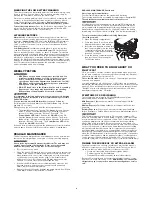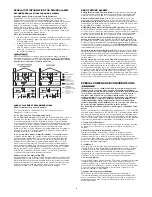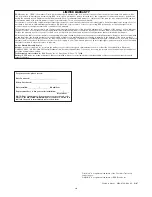
Choosing a replacement battery:
Your Smoke/CO Alarm requires two standard AA batteries.
The following batteries are acceptable as replacements: Energizer E91.
These batteries are available at many local retail stores.
Actual battery service life depends on the Smoke/CO Alarm and the
environment in which it is installed. All the batteries specified above
are acceptable replacement batteries for this unit. Regardless of the
manufacturer’s suggested battery life, you MUST replace the battery
immediately once the unit starts “chirping” (the “low battery warning”).
REGULAR MAINTENANCE
This unit has been designed to be as maintenance-free as possible, but
there are a few simple things you must do to keep it working properly.
Use only the replacement batteries listed below. The unit may not
operate properly with other batteries. Never use rechargeable
batteries since they may not provide a constant charge.
•
Test it at least once a week.
•
Clean the Smoke/CO Alarm at least once a month; gently vacuum the
outside of the Smoke/CO Alarm using your household vacuum’s soft
brush attachment. A can of clean compressed air (sold at computer
or office supply stores) may also be used. Follow manufacturer
instructions for use. Test the Smoke/CO Alarm. Never use water,
cleaners or solvents since they may damage the unit.
•
If the Smoke/CO Alarm becomes contaminated by excessive dirt,
dust and/or grime, and cannot be cleaned to avoid unwanted
alarms, replace the unit immediately.
•
Relocate the unit if it sounds frequent unwanted alarms. See “Where
This Alarm Should Not Be Installed” for details.
To replace the batteries (without removing Alarm from
the ceiling or wall):
1. Open the battery compartment.
2. Press tabs A and B as shown in the
diagram and remove each battery.
3. Insert the new batteries, making sure
they snap completely into the battery
compartment. Match the terminals
on the ends of the batteries with the
terminals on the unit.
4. Close the battery compartment, and
then test the unit by pressing the
Test/Silence button.
AB
WEEKLY TESTING
• NEVER use an open flame of any kind to test this unit. You
might accidentally damage or set fire to the unit or to your
home. The built-in test switch accurately tests the unit’s
operation as required by Underwriters Laboratories, Inc. (UL).
NEVER use vehicle exhaust! Exhaust may cause permanent
damage and voids your warranty.
• DO NOT stand close to the Alarm when the horn is sounding.
Exposure at close range may be harmful to your hearing.
When testing, step away when horn starts sounding.
It is important to test this unit every week to make sure it is working
properly. Using the test button is the recommended way to test this
Smoke/CO Alarm.
You can test this Smoke/CO Alarm by pressing and holding the
Test/Silence button on the Alarm cover until Alarm Voice says “Testing”
(typically 3-5 seconds).
During testing, you will see and hear the following sequence:
• The Alarm Voice will say “Testing.” The Horn will sound 3 beeps,
pause, 3 beeps. The Alarm Voice will say “Warning, evacuate
smoke in [Location, example: “Kitchen”]. Evacuate.” The
Power/Smoke LED flashes Red and the CO LED will be Off.
• Next the Horn will sound 4 beeps, pause, 4 beeps. The Alarm
Voice will say “Warning, evacuate carbon monoxide in [Location,
example: “Kitchen”]. Evacuate.” The Power/Smoke LED will be
Off and the CO LED flashes Red.
If the unit does not alarm, make sure the batteries are correctly installed,
and test again. If the unit still does not alarm, replace it immediately.
SILENCING THE LOW BATTERY WARNING
This silence feature can temporarily quiet the low battery warning “chirp”
for up to 8 hours. You can silence the low battery warning “chirp” by
pressing the Test/Silence button on the alarm cover.
Once the low battery warning “chirp” silence feature is activated, the unit
continues to flash the Green light twice a minute for 8 hours. After 8
hours, the low battery “chirp” will resume. Replace the batteries as
soon as possible; this unit will not operate without battery power!
To deactivate this feature:
Press the Test/Silence button again. The unit
will go into Test Mode and the low battery warning will resume (LED
flashes and unit sounds “chirp” once a minute).
LATCHING FEATURES
Alarm Latch is activated after an Alarm is exposed to alarm levels of
smoke or carbon monoxide. After smoke or CO levels drop below alarm
levels, the “Smoke/Power” LED and/or the “CO” Red LED will begin to
flash On for 2 seconds/Off for 2 seconds. It will continue to flash or
“latch” for about 15 minutes, to give you time to determine which unit
initiated the alarm.
Low Battery Latch is activated when the Alarm is in the "low battery
condition". When this occurs, the Smoke/Power LED flashes Green
On for 2 seconds/Off for 2 seconds for about 15 minutes. This feature
is designed to help you identify which Alarm needs to have the battery
replaced. Although, the Alarm will sound the low battery chirp approxi-
mately once every minute, sometimes during the initial stages of "low
battery", the Alarm will chirp in greater intervals than one minute, some-
times up to several hours, until the battery reaches a steady low battery
level. This innovative feature eliminates the frustration of waiting for
and/or identifying which unit is chirping.
6
WHAT YOU NEED TO KNOW ABOUT CO
WHAT IS CO?
CO is an invisible, odorless, tasteless gas produced when fossil fuels
do not burn completely, or are exposed to heat (usually fire). Electrical
appliances typically do not produce CO.
These fuels include: Wood, coal, charcoal, oil, natural gas, gasoline,
kerosene, and propane.
Common appliances are often sources of CO. If they are not properly
maintained, are improperly ventilated, or malfunction, CO levels can rise
quickly. CO is a real danger now that homes are more energy efficient.
“Air-tight” homes with added insulation, sealed windows, and other
weatherproofing can “trap” CO inside.
SYMPTOMS OF CO POISONING
These symptoms are related to CO POISONING and should be
discussed with ALL household members.
Mild Exposure: Slight headache, nausea, vomiting, fatigue (“flu-like”
symptoms).
Medium Exposure: Throbbing headache, drowsiness, confusion, fast
heart rate.
Extreme Exposure: Convulsions, unconsciousness, heart and lung
failure. Exposure to Carbon Monoxide can cause brain damage, death.
This CO Alarm measures exposure to CO over time. It alarms if CO
levels are extremely high in a short period of time, or if CO levels reach
a certain minimum over a long period of time. The CO Alarm generally
sounds an alarm before the onset of symptoms in average, healthy
adults. Why is this important? Because you need to be warned of a
potential CO problem while you can still react in time. In many reported
cases of CO exposure, victims may be aware that they are not feeling
well, but become disoriented and can no longer react well enough to
exit the building or get help. Also, young children and pets may be the
first affected. The average healthy adult might not feel any symptoms
when the CO Alarm sounds. However, people with cardiac or respiratory
problems, infants, unborn babies, pregnant mothers, or elderly people
can be more quickly and severely affected by CO. If you experience
even mild symptoms of CO poisoning, consult your doctor immediately!
FINDING THE SOURCE OF CO AFTER AN ALARM
Carbon monoxide is an odorless, invisible gas, which often makes it
difficult to locate the source of CO after an alarm. These are a few of
the factors that can make it difficult to locate sources of CO:
• House well ventilated before the investigator arrives.
• Problem caused by “backdrafting.”
• Transient CO problem caused by special circumstances.
Because CO may dissipate by the time an investigator arrives, it may
be difficult to locate the source of CO. BRK Brands, Inc. shall not be
obligated to pay for any carbon monoxide investigation or service
call.
REGULAR MAINTENANCE, Continued
























